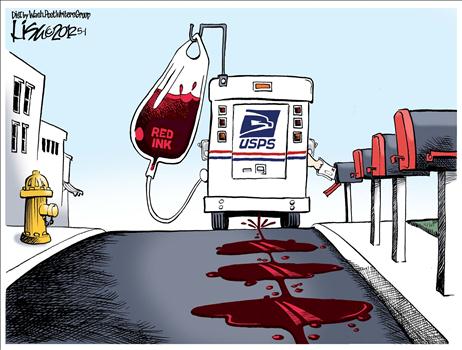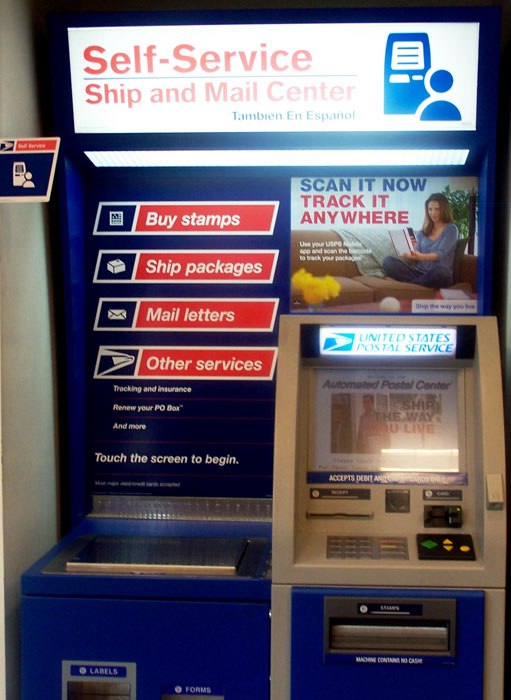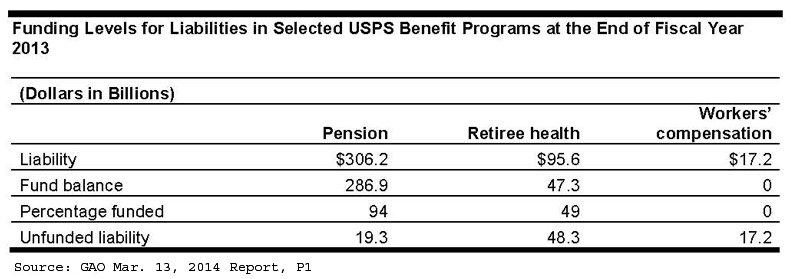
U.S. Post Office Now Faces $100 Billion in Unfunded Liabilities – GAO
original article written by Net Advisor™
WASHINGTON DC. In 2008, the United States Postal Service (USPS) via the National Association of Letter Carriers, AFL-CIO union said, “USPS is funded entirely by revenues from postage.” Since 2008, USPS went from “self-sufficient” to technically bankrupt in just 4 years (Report).
USPS debt has continued to climb under President Obama’s watch. In 2012, I discussed USPS defaulted on a $5 Billion taxpayer loan and was sitting on $15 Billion in debt. The General Accountability Office (GAO) published an updated report on USPS financials which now show the U.S. Postal Service facing $100 Billion (or currently $99.8 Billion to be more precise) in unfunded liabilities (Chart below – add last line in each column = $99.8 Billion).
“USPS continues to be in a serious financial crisis, with insufficient revenue to cover its expenses and financial obligations as the volume of USPS’s most profitable product, First Class Mail, continues to decline.
At the end of fiscal year 2013, USPS had about $100 billion in unfunded liabilities: $85 billion in unfunded liabilities for benefits, including retiree health, pension, and workers compensation liabilities, and $15 billion in outstanding debt to the U.S. Treasury the statutory limit.”
— Source: GAO, March 13, 2014 Report (Highlights, PDF, 1-page) (Full Report, PDF 20pps)
The GAO further stated that the USPS unfunded liabilities went from 83 percent of USPS revenues in 2007 to now 148 percent of revenues in 2013. Just a little FYI, when costs exceeded revenues one is technically bankrupt. Thus, USPS with unfunded liabilities at 148 percent of revenues is a financial disaster.
- Analysis: USPS Financial Crisis – Our 2013 Report
USPS has most of its current pension liability funded but clearly not enough. USPS also has been funding employee retirement healthcare costs on a “pay-as-you-go” – pay as costs incur each year. The problem is, health care costs have been soaring over the years and will continue to soar under the Affordable Care Act (ACA) or “ObamaCare” according to the non-partisan Congressional Budget Office. The USPS has not prefunded any of its healthcare liability (GAO, P8).
USPS warned that they could default on their healthcare payments back in 2011. So far, USPS defaulted on its healthcare payments in 2012 and 2013 (PDF). In three years, USPS has still not successfully been able to get a hold of their financial house.
The failure to adequately address this issue by the Obama Administration has not solved USPS’ debt problem. Part of the problem is fewer people are using first class mail service to send letters or pay bills, and this is where USPS makes most of its money. With email, instant messaging expanding since the 1990’s, and increasing use of text messaging and on-line bill pay, there is less of a need to use first class mail.
The USPS has been closing offices but its debt has continued to increase beyond the savings. USPS could save money by ending Saturday delivery but that idea was dropped in 2013.
Duplicate Labor
In 2010, I wrote a light humorous article where I observed an USPS store had duplicate labor – two people doing basically the same job. This job protection method is classic government inefficiency.
Despite the financial issues, in my experience postal workers are friendly, very professional, and are just doing their job. I spoke to one postal employee about a recent closing of their office on Saturdays, and a cut in service by two hours a day.
I said, “are you guys getting hit with a pay cut given the cut hours and Saturday close?” The postal employee responded, “no, we’re still getting the same pay.” The USPS employee was concerned about future pay cuts but no official word at this time.
The issue here is clearly aligned with upper operational management who needs to more aggressively address their financial risks which will affect their employees, and U.S. taxpayers.

More Duplicate Labor?
Over recent weeks I had been observing USPS employees working the automated “self-help” postal machines inside the post office. These APS machines have been in service since 1998.
In my experience, the automated self-help postal machine can save 10-20 minutes of wait-time for a counter employee to do the same job. The machine is never late, doesn’t require healthcare or a pension. Yes, no one likes to be replaced by a machine, and the machine can’t do everything – yet, but USPS could save money from having two people doing the same job.
Did Job Cuts Lead to More Hiring?
From 2007 to 2011, USPS reportedly cut 110,000 jobs, but still had 583,908 “career employees.” For those who think USPS is serious about cutting its liabilities, you might want to think again.
“According to the Postal Service Active Employee Statistical Summary for Pay Period 19, the USPS has 627,469 active employees, including 489,081 full-time employees.”
— Source: PostalMag.com [USPS Pay Period (2012) Report, PDF]
So instead of reducing its total liabilities, USPS increased its labor costs which have only increased its total liabilities. Pretend you own a business that was losing billions, and fewer people were using your products. Would your solution be to hire more people, and increase your debt? That’s what USPS did, and now taxpayers may get stuck with the bag.
The result of this continued inefficiency could result in some sort of taxpayer bailout. One plan (PDF) to “save” USPS money is to transfer some of their own healthcare liabilities to Medicare. This is also called a taxpayer bailout, and is like paying one credit card with another credit card.
____________________________________________________________________________
Original article content, Copyright © 2014 NetAdvisor.org® All Rights Reserved.
NetAdvisor.org® is a non-profit organization providing public education and analysis primarily on the U.S. financial markets, personal finance and analysis with a transparent look into U.S. public policy. We also perform and report on financial investigations to help protect the public interest. Read More.
___________________________________________________________________________


